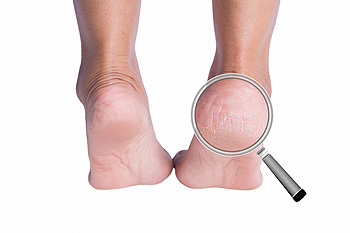Dr. Kennan T. Runte, DPM, FACFAS
Dr. Panah Nabili, DPM
Grass Valley, CA 95945
Dr. Kennan T. Runte, DPM, FACFAS
Dr. Panah Nabili, DPM

Patients who have peripheral arterial disease (PAD) often experience poor circulation. They may have cold feet or hands, the skin on the feet may become cracked, and the toenails may become brittle. Additionally, patients who smoke may be at risk of poor circulation. Improving eating habits may also help to control this condition. People who have diabetes and elevated blood pressure or cholesterol levels may be prone to developing poor circulation. Many diabetic patients have implemented coping tactics that may help to relieve some of the symptoms. These may consist of having the feet examined regularly, which will include a test for poor circulation. Additionally, performing a gentle exercise routine may help to improve poor circulation. Controlling blood pressure and cholesterol levels may benefit heart function, improving circulation. If you notice signs of poor circulation in your feet, it is suggested that you consult with a podiatrist who can help you to manage this condition.
While poor circulation itself isn’t a condition; it is a symptom of another underlying health condition you may have. If you have any concerns with poor circulation in your feet contact one of our podiatrists of Foothill Podiatry Clinic. Our doctors will treat your foot and ankle needs.
Poor Circulation in the Feet
Peripheral artery disease (PAD) can potentially lead to poor circulation in the lower extremities. PAD is a condition that causes the blood vessels and arteries to narrow. In a linked condition called atherosclerosis, the arteries stiffen up due to a buildup of plaque in the arteries and blood vessels. These two conditions can cause a decrease in the amount of blood that flows to your extremities, therefore resulting in pain.
Symptoms
Some of the most common symptoms of poor circulation are:
Treatment for poor circulation often depends on the underlying condition that causes it. Methods for treatment may include insulin for diabetes, special exercise programs, surgery for varicose veins, or compression socks for swollen legs.
As always, see a podiatrist as he or she will assist in finding a regimen that suits you. A podiatrist can also prescribe you any needed medication.
If you have any questions, please feel free to contact our office located in Grass Valley, CA . We offer the newest diagnostic and treatment technologies for all your foot care needs.

There’s an old saying: What price beauty? And when it comes to footwear for women, that is the question. Choosing fashion over foot health is common, but in many cases, a high price is paid. The footwear determined to be likely to cause foot, ankle, or toe pain are high heels, flip-flops, stilettos, shoes with pointy toes, and ballet flats. High heels often have pointy toe boxes and stiletto, or thin, heels. This leaves the wearer open to several problems, including pain in the ball of the feet, instability, and sprained ankles. They can also be responsible for bunion pain, corns, hammertoes, and claw toes. Flip-flops offer little to no support for the feet, causing the feet to work harder with each step and expose the heels to cracks and fissures. Because they contain limited cushioning, flip-flops may even contribute to heel pain from plantar fasciitis. Ballet flats rarely have arch support, offering little to no protection from injury, and can lead to knee, hip, and back problems. To learn more about shoes that can promote good health for your feet, please consult a podiatrist.
High heels have a history of causing foot and ankle problems. If you have any concerns about your feet or ankles, contact one of our podiatrists from Foothill Podiatry Clinic. Our doctors can provide the care you need to keep you pain-free and on your feet.
Effects of High Heels on the Feet
High heels are popular shoes among women because of their many styles and societal appeal. Despite this, high heels can still cause many health problems if worn too frequently.
Which Parts of My Body Will Be Affected by High Heels?
What Kinds of Foot Problems Can Develop from Wearing High Heels?
How Can I Still Wear High Heels and Maintain Foot Health?
If you want to wear high heeled shoes, make sure that you are not wearing them every day, as this will help prevent long term physical problems. Try wearing thicker heels as opposed to stilettos to distribute weight more evenly across the feet. Always make sure you are wearing the proper shoes for the right occasion, such as sneakers for exercising. If you walk to work, try carrying your heels with you and changing into them once you arrive at work. Adding inserts to your heels can help cushion your feet and absorb shock. Full foot inserts or metatarsal pads are available.
If you have any questions please feel free to contact our office located in Grass Valley, CA . We offer the newest diagnostic and treatment technologies for all your foot and ankle needs.

People who have cracked heels are often aware of how their feet look in flip flops, or other types of backless shoes. This condition can be unsightly, and it affects approximately 20 percent of people across the country. There are various reasons why cracked heels can develop. These can include standing on hard surfaces for much of the day and wearing shoes that do not support the heels. Additionally, there are certain medical ailments that may promote getting cracked heels, consisting of fungal infections and thyroid disorders. People who have psoriasis or specific vitamin deficiencies may be prone to getting this condition, and there are methods that can be implemented, which may help to prevent them. It is beneficial to wash and dry the feet thoroughly, followed by applying a good moisturizer on them. Wearing shoes that have a back may also help to stop the onset of cracked heels. For mildly cracked heels, some patients use a pumice stone that can exfoliate the dead skin. Severely cracked heels often require the expert advice of a podiatrist. If you have this condition, please contact this type of doctor who can prescribe medication for relief, if necessary.
If the skin on your feet starts to crack, you may want to see a podiatrist to find treatment. If you have any concerns, contact one of our podiatrists from Foothill Podiatry Clinic. Our doctors can provide the care you need to keep you pain-free and on your feet.
Cracked Heels
It is important to moisturize your cracked heels in order to prevent pain, bleeding, and infection. The reason cracked heels form is because the skin on the foot is too dry to support the immense pressure placed on them. When the foot expands, the dry skin on the foot begins to split.
Ways to Help Heal Them
Ways to Prevent Cracked Heels
If you are unsure how to proceed in treating cracked heels, seek guidance from a podiatrist. Your doctor will help you with any questions or information you may need.
If you have any questions, please feel free to contact our office located in Grass Valley, CA . We offer the newest diagnostic and treatment technologies for all your foot care needs.

Toes are made up of two or three small, fragile bones. A toe bone can break or fracture when it is stubbed, or if something heavy is dropped on it. Broken toes are common, and treatment is often successful by staying off of the affected foot and elevating it. Additionally, using the buddy taping method, or taping the broken toe to the toe next to it, can help to provide stability that is needed. If one has a severe toe fracture, the big toe may be involved, and a break may cause the toe to become crooked. Tiny fragments of bone can break off, and may result in an open wound. Injuries to the big toe may need a cast or splint for proper healing, and more severe fractures may require surgery. When an individual breaks a toe, they often feel pain, and the toe may become bruised, swollen, and stiff. If you think you have broken your toe and home care methods are not helping, please consult with a podiatrist who can perform a proper diagnosis and provide treatment options that are right for you.
Broken toes may cause a lot of pain and should be treated as soon as possible. If you have any concerns about your feet, contact one of our podiatrists from Foothill Podiatry Clinic. Our doctors will treat your foot and ankle needs.
What Is a Broken Toe?
A broken toe occurs when one or more of the toe bones of the foot are broken after an injury. Injuries such as stubbing your toe or dropping a heavy object on it may cause a toe fracture.
Symptoms of a Broken Toe
Although the injured toe should be monitored daily, it is especially important to have a podiatrist look at your toe if you have severe symptoms. Some of these symptoms include worsening or new pain that is not relieved with medication, sores, redness, or open wounds near the toe.
If you have any questions, please feel free to contact our office located in Grass Valley, CA . We offer the newest diagnostic and treatment technologies for all your foot care needs.